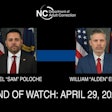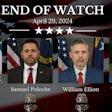Law enforcement officers confronted with a violent, unpredicatable subject may be up against someone with a condition known as excited delirium. Officers encountering such a subject will notice a combination of delirium, psychomotor agitation, anxiety, hallucinations, speech disturbances, disorientation, violent and bizarre behavior, insensitivity to pain, elevated body temperature, and superhuman strength.
If a subject dies from cardiac arrest while in custody or after the use of less-lethal force such as a TASER, the condition is known as excited delirium syndrome (EDS).
EDS is often associated with males with histories of illicit drug use and/or mental illness. While slowly gaining acceptance as a legitimate cause of death, it is the chaos and emotion witnessed by bystanders that can cause public scrutiny.
Here's a quick but not comprehensive list of causes of abnormal (possibly combative) suspect behavior and their pitfalls. In fire/EMS, this is known as a differential diagnosis.
- Overdose: This can result in respiratory and/or cardiac arrest, depending on the substance ingested, which can be illicit drugs, prescription meds, homebrews or "fad" drinks (think Four Loko).
- Head injury: Trauma from assault, sports injury or accident: An internal head bleed can lead to respiratory arrest leading to cardiac arrest.
- Hypoglycemia: Insulin dependent diabetics must take insulin to regulate the sugar in their body. If the insulin is not followed by a meal or if the person has a cold/infection, he or she can develop hypoglycemia (low blood-sugar) and present with bizarre/combative behavior.
- Carbon monoxide poisoning in winter months: This is a high risk due to alternative open flame heat sources and poor ventilation.
- Mental illness: Due to early recognition and treatment, higher numbers of college students are enrolling that have histories of mental illness. Non-compliance with prescription meds and psycho stimulant drug use can result in a psychotic event.
- Post Traumatic Stress Disorder (PTSD): Currently, 300,000 veterans are taking advantage of their college benefits. Numbers as high as one in eight of combat veterans may be afflicted with PTSD. Though rare, some can present with violent psychotic- like episodes if a trigger is encountered. This is less likely to occur to the veteran who has received a diagnosis and treatment for his or her condition.
Unlike municipal law enforcement, college campus police and security are typically dealing with young adults. Campus officers seldom have to deal with members of society who suffer from long-term addiction, and unmanaged and untreated mental illness. While the typical call for a university officer may not involve the hardened and experienced criminals faced by "big city" law enforcement, they are facing a much more complex and delicate situation when confronted by a subject presenting with combative or bizarre behavior.
This individual is likely not to be a hardened criminal, and any infractions being committed are minor. They are probably the result of some poor choices that were made a few hours earlier and not because of intent for wrongdoing.
That being said, the disorderly behavior of college students can be challenging and must be dealt with appropriately. Otherwise, campus police, fire or EMS could suffer the scrutiny of an emotional uninformed public whipped into frenzy by media sensationalism.
When an agitated or violent individual is subdued, restrained and "packaged" for transport, the entire world gets to witness the chaos, thanks to the World Wide Web. If injury or death occurs, whether it is in a patrol car or in a medic unit, the campus will feel the impact. What could be a routine procedure will now be labeled police brutality due to lack of communication and relevant education and training of the officers.
Behavior Sometimes Is Caused by Medical Issues
Sometimes, the cause of the behavior may have medical origins. (see sidebar on page 42) Most agencies provide their members with the basic training in First Aid and CPR. This addresses airway, breathing and circulation (ABCs). The ability of a campus public safety officer to recognize a medical emergency is every bit as important as the treatment of a medical emergency.
The Pediatric Assessment Triangle (see sidebar on page 2 of this article) is included in several courses designed to help rapidly identify a sick child in need of advanced life support (ALS). It is taught to pediatricians, pediatric nurses, flight nurses and paramedics. The concepts of this assessment tool have been incorporated into adult evaluations as well through Competency Based Training (CBT) and Ongoing Training and Evaluation Program (OTEP). These training modules are scenario based and are part of fire/EMS continuing medical education.
A campus law enforcement officer lacking a medical background can be trained to determine the need for further fire/EMS evaluation from a safe distance away using this model. This over-simplified explanation is not a substitute for an accredited, scenario-based training course. It is only intended to raise awareness of the tools available to recognize an individual in need of fire/EMS evaluation, treatment and transport.
Traditional methods of de-escalation, subdual and restraint are not effective on all subjects encountered in the field. This also applies to methods of compliance and incapacitation.
Without relevant training, any attempts to manage the out of control individual presenting with bizarre and/or combative behavior will make an officer appear undisciplined and unprofessional, imposing his or her will upon another hapless victim. New tactics and techniques need to be incorporated that reflect the changing conditions faced by first responders. Also, incorporating fire/EMS into training exercises will familiarize everyone on a plan of action that is proactive rather than reactive.
Pediatric Assessment Triangle
From a safe distance away from the subject, a campus law enforcement officer can be trained to use this model to determine if the individual needs further fire/EMS evaluation.
Appearance
How does the suspect look? Is there blood or other signs of obvious injury? Are they agitated or calm? Are their interactions with the environment appropriate?
Work of breathing
How much effort is the individual making to breathe? What is the rate of his breathing? A normal breathing pattern is 12 to 20 respirations per minute and is an effortless rhythmic rise and fall of the chest. This range covers being at rest to speaking and walking. Anything below or above this, with or without effort, is worth further evaluation by fire/EMS.
Circulation to skin
The last part of the assessment triangle is an indicator of oxygenation and/or how efficiently the heart is pumping. It is the most difficult to assess without touching the individual and is further complicated by struggle and the application of restraints. Essentially, the evaluator will have to rely on seeing mottled skin, blue lips, pale gums and mucous membranes as indicators of poor blood circulation to the skin.
Michael W. Weaver is a 15-year veteran of the Everett (Wash.) Fire Department. He is also an author and trainer. For a more detailed review of these items and more pictures, please click here.













